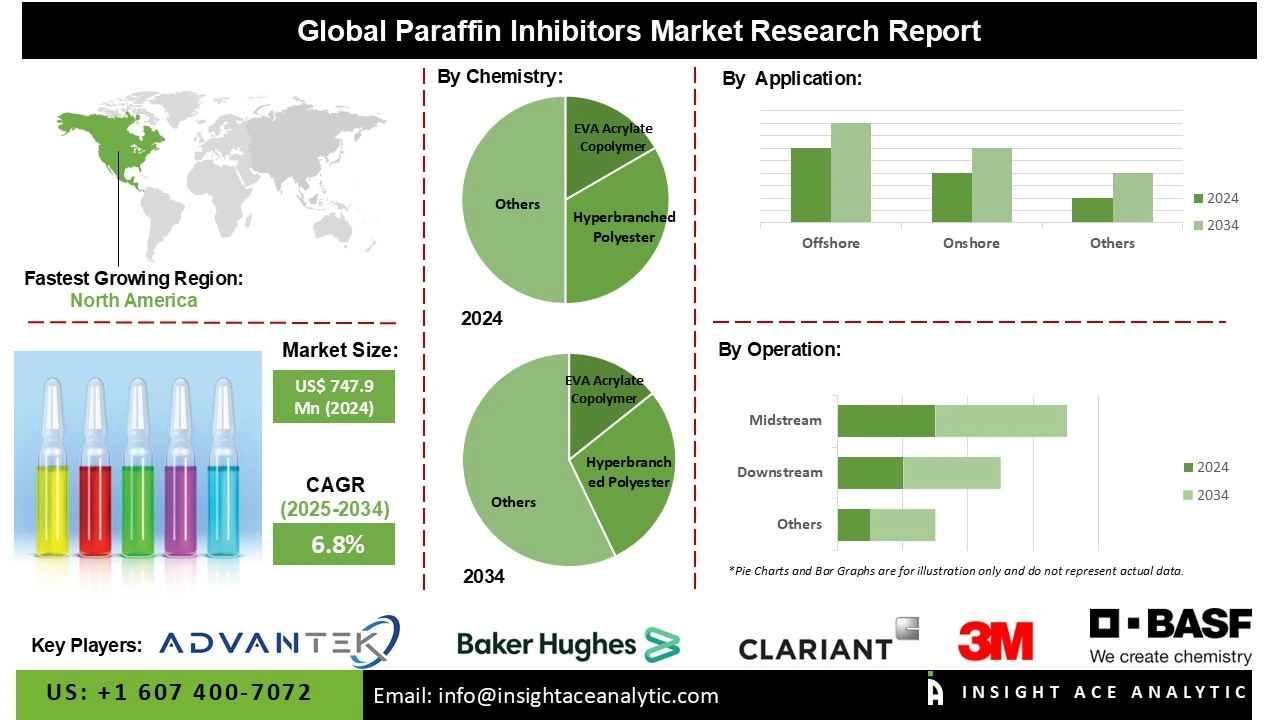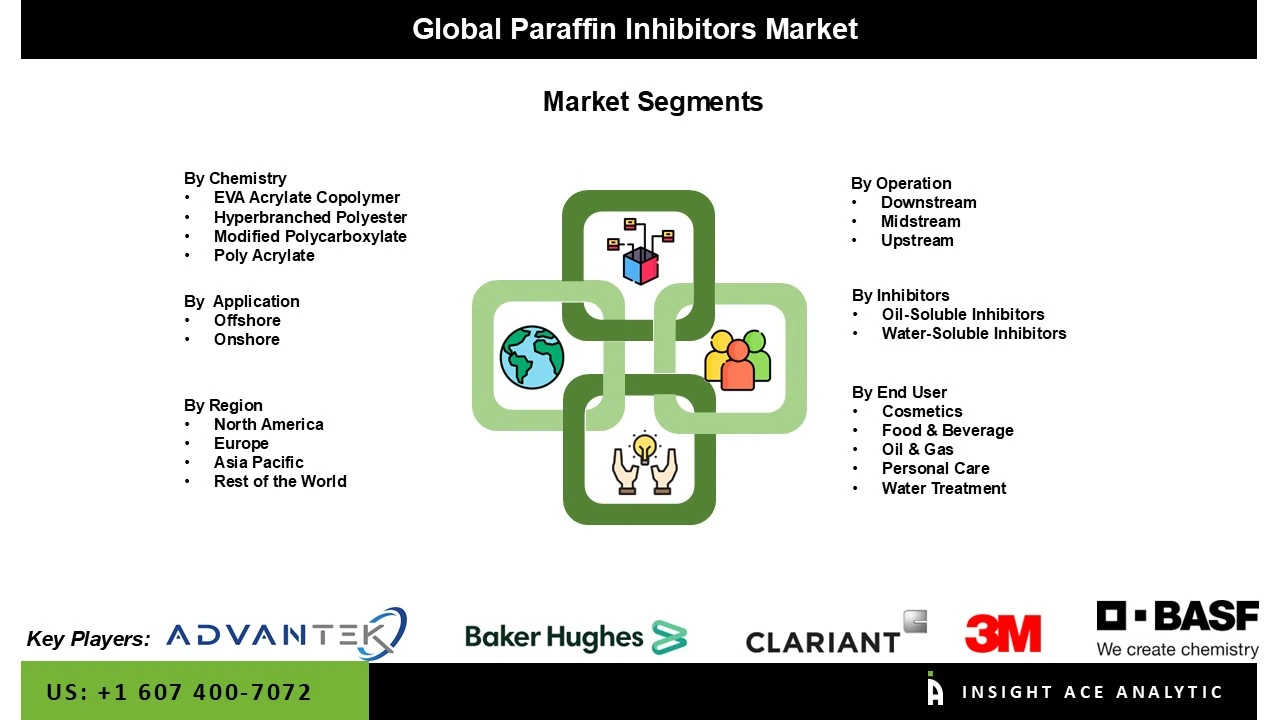Global Paraffin Inhibitors Market Size is valued at US$ 747.9 Mn in 2024 and is predicted to reach US$ 1,412.6 Mn by the year 2034 at an 6.8% CAGR during the forecast period for 2025-2034.
Paraffin inhibitors are chemical additives used in the oil and gas industry to prevent or reduce the deposition of paraffin wax in pipelines and equipment, ensuring smooth flow, operational efficiency, and reduced maintenance costs. The paraffin inhibitors market is experiencing substantial growth, primarily driven by the rising requirement for oil and gas pipelines. Paraffin residue in pipelines can cause blockages, decrease flow efficiency, and increase operational costs, making inhibitors essential for smooth hydrocarbon transportation.

The increasing global energy demand and expansion of crude oil production have intensified pipeline usage, further boosting the requirement for effective paraffin management solutions. Additionally, the adoption of cutting-edge chemical formulations that prevent wax crystallization, along with stricter operational security standards in the oil and gas sector, is propelling market growth. Continuous investment in pipeline infrastructure in emerging regions also supports sustained demand for paraffin inhibitors.
The paraffin inhibitors market is experiencing robust growth, primarily driven by the increasing need for underwater pipelines in global energy infrastructure. Paraffin deposition in oil pipelines can cause blockages, decrease flow efficiency, and increase maintenance costs, posing significant operational challenges, particularly in deepwater and subsea oil extraction. As the global energy sector extends and offshore exploration intensifies, there is an increasing need for reliable solutions to prevent wax buildup. Paraffin inhibitors allow smooth crude oil transport, enhance pipeline longevity, and reduce operational downtime. Moreover, stringent regulations on pipeline safety and efficiency, coupled with rising investments in oil and gas infrastructure worldwide, are further strengthening market demand.
Some of the Key Players in the Paraffin Inhibitors Market:
· 3M
· Advantek
· Baker Hughes
· BASF
· Clariant
· Croda
· Desco
· Dorf Ketal Chemicals
· Dow
· Halliburton
· Mondi
· Nordic
· Nouryon
· Schlumberger
· Sonoco
The paraffin inhibitors market is segmented by type of chemistry, by type of operation, by type of inhibitors, by area of application, by end-user, and by region. By type of chemistry, the market is segmented into EVA acrylate copolymer, hyperbranched polyester, modified polycarboxylate, and poly acrylate. By type of operation, the market is segmented into downstream, midstream, and upstream. By type of inhibitors, the market is segmented into oil-soluble inhibitors, and water-soluble inhibitors. By area of application, the market is segmented into offshore, and onshore. By end-user, the market is segmented into cosmetics, food & beverage, oil & gas, personal care, and water treatment.
The modified polycarboxylate is estimated to have a considerable market share by 2024 due to the growing requirement to minimize wax deposition in crude oil pipelines, which can cause clogs and reduced flow efficiency. Modified polycarboxylates operate as effective pour point depressants, increasing oil flow at low temperatures. Rising oil and gas production in cold climates, along with tightening requirements on operating efficiency and maintenance costs, is pushing demand for this technology. Furthermore, advances in inhibitor formulations and increased application in upstream and midstream activities drive market expansion.
Oil-soluble inhibitors dominate the paraffin inhibitors market due to the growing requirement to prevent wax deposition in pipelines, which can disrupt crude oil flow and decrease operational efficiency. Oil-soluble inhibitors are preferred for their compatibility with hydrocarbon systems and effectiveness in high-temperature reservoirs. Major drivers include the increasing global oil and gas production, the push for uninterrupted flow in ageing and deepwater wells, and stringent operational standards that require reliable flow assurance solutions to decrease maintenance expenses and production losses.
North America dominates the market for paraffin inhibitors due to the growing oil and gas production in shale and conventional reservoirs within region, where paraffin deposition can clog pipelines and reduce flow efficiency. Regional growth is also contributed to the increasing need to maintain uninterrupted oil flow and minimise operational downtime, which is driving the adoption of chemical inhibitors. Additionally, stringent regulations on production efficiency and cost optimization, combined with technological advancements in inhibitor formulations, are further expected to push market growth in the region.
Furthermore, Europe's paraffin inhibitors industry is being driven by the region's increased oil and gas production, where paraffin deposition in pipelines reduces flow efficiency and raises maintenance costs. The necessity to maintain uninterrupted production in aged areas, as well as the increased need for better oil recovery techniques, are key factors. The use of improved chemical inhibitors to prevent wax deposition, combined with tight rules governing operating safety and efficiency, is driving market expansion.
Paraffin Inhibitors Market by Type of Chemistry-
· EVA Acrylate Copolymer
· Hyperbranched Polyester
· Modified Polycarboxylate
· Poly Acrylate

Paraffin Inhibitors Market by Type of Operation-
· Downstream
· Midstream
· Upstream
Paraffin Inhibitors Market by Type of Inhibitors-
· Oil-Soluble Inhibitors
· Water-Soluble Inhibitors
Paraffin Inhibitors Market by Area of Application-
· Offshore
· Onshore
Paraffin Inhibitors Market by End-User-
· Oil-Soluble Inhibitors
· Water-Soluble Inhibitors
Paraffin Inhibitors Market by Region-
North America-
· The US
· Canada
Europe-
· Germany
· The UK
· France
· Italy
· Spain
· Rest of Europe
Asia-Pacific-
· China
· Japan
· India
· South Korea
· Southeast Asia
· Rest of Asia Pacific
Latin America-
· Brazil
· Argentina
· Mexico
· Rest of Latin America
Middle East & Africa-
· GCC Countries
· South Africa
· Rest of the Middle East and Africa
Chapter 1. Methodology and Scope
1.1. Research Methodology
1.2. Research Scope & Assumptions
Chapter 2. Executive Summary
Chapter 3. Global Paraffin Inhibitors Market Snapshot
Chapter 4. Global Paraffin Inhibitors Market Variables, Trends & Scope
4.1. Market Segmentation & Scope
4.2. Drivers
4.3. Challenges
4.4. Trends
4.5. Investment and Funding Analysis
4.6. Porter's Five Forces Analysis
4.7. Incremental Opportunity Analysis (US$ MN), 2025-2034
4.8. Competitive Landscape & Market Share Analysis, By Key Player (2024)
4.9. Use/impact of AI on Paraffin Inhibitors Market Industry Trends
4.10. Global Paraffin Inhibitors Market Penetration & Growth Prospect Mapping (US$ Mn), 2024-2034
Chapter 5. Paraffin Inhibitors Market Segmentation 1: By Chemistry, Estimates & Trend Analysis
5.1. Market Share by Chemistry, 2024 & 2034
5.2. Market Size Revenue (US$ Million) & Forecasts and Trend Analyses, 2021 to 2034 for the following Chemistry:
5.2.1. EVA Acrylate Copolymer
5.2.2. Hyperbranched Polyester
5.2.3. Modified Polycarboxylate
5.2.4. Poly Acrylate
Chapter 6. Paraffin Inhibitors Market Segmentation 2: By Operation, Estimates & Trend Analysis
6.1. Market Share by Operation, 2024 & 2034
6.2. Market Size Revenue (US$ Million) & Forecasts and Trend Analyses, 2021 to 2034 for the following Operation:
6.2.1. Downstream
6.2.2. Midstream
6.2.3. Upstream
Chapter 7. Paraffin Inhibitors Market Segmentation 3: By Application, Estimates & Trend Analysis
7.1. Market Share by Application, 2024 & 2034
7.2. Market Size Revenue (US$ Million) & Forecasts and Trend Analyses, 2021 to 2034 for the following Application:
7.2.1. Offshore
7.2.2. Onshore
Chapter 8. Paraffin Inhibitors Market Segmentation 4: By Inhibitors, Estimates & Trend Analysis
8.1. Market Share by Inhibitors, 2024 & 2034
8.2. Market Size Revenue (US$ Million) & Forecasts and Trend Analyses, 2021 to 2034 for the following Inhibitors:
8.2.1. Oil-Soluble Inhibitors
8.2.2. Water-Soluble Inhibitors
Chapter 9. Paraffin Inhibitors Market Segmentation 5: By End User, Estimates & Trend Analysis
9.1. Market Share by End User, 2024 & 2034
9.2. Market Size Revenue (US$ Million) & Forecasts and Trend Analyses, 2021 to 2034 for the following End User:
9.2.1. Cosmetics
9.2.2. Food & Beverage
9.2.3. Oil & Gas
9.2.4. Personal Care
9.2.5. Water Treatment
Chapter 10. Paraffin Inhibitors Market Segmentation 6: Regional Estimates & Trend Analysis
10.1. Global Paraffin Inhibitors Market, Regional Snapshot 2024 & 2034
10.2. North America
10.2.1. North America Paraffin Inhibitors Market Revenue (US$ Million) Estimates and Forecasts by Country, 2021-2034
10.2.1.1. US
10.2.1.2. Canada
10.2.2. North America Paraffin Inhibitors Market Revenue (US$ Million) Estimates and Forecasts by Chemistry, 2021-2034
10.2.3. North America Paraffin Inhibitors Market Revenue (US$ Million) Estimates and Forecasts by Operation, 2021-2034
10.2.4. North America Paraffin Inhibitors Market Revenue (US$ Million) Estimates and Forecasts by Application, 2021-2034
10.2.5. North America Paraffin Inhibitors Market Revenue (US$ Million) Estimates and Forecasts by Component, 2021-2034
10.2.6. North America Paraffin Inhibitors Market Revenue (US$ Million) Estimates and Forecasts by Inhibitors, 2021-2034
10.2.7. North America Paraffin Inhibitors Market Revenue (US$ Million) Estimates and Forecasts by End User, 2021-2034
10.3. Europe
10.3.1. Europe Paraffin Inhibitors Market Revenue (US$ Million) Estimates and Forecasts by Country, 2021-2034
10.3.1.1. Germany
10.3.1.2. U.K.
10.3.1.3. France
10.3.1.4. Italy
10.3.1.5. Spain
10.3.1.6. Rest of Europe
10.3.2. Europe Paraffin Inhibitors Market Revenue (US$ Million) Estimates and Forecasts by Chemistry, 2021-2034
10.3.3. Europe Paraffin Inhibitors Market Revenue (US$ Million) Estimates and Forecasts by Operation, 2021-2034
10.3.4. Europe Paraffin Inhibitors Market Revenue (US$ Million) Estimates and Forecasts by Application, 2021-2034
10.3.5. Europe Paraffin Inhibitors Market Revenue (US$ Million) Estimates and Forecasts by Inhibitors, 2021-2034
10.3.6. Europe Paraffin Inhibitors Market Revenue (US$ Million) Estimates and Forecasts by End User, 2021-2034
10.4. Asia Pacific
10.4.1. Asia Pacific Paraffin Inhibitors Market Revenue (US$ Million) Estimates and Forecasts by Country, 2021-2034
10.4.1.1. India
10.4.1.2. China
10.4.1.3. Japan
10.4.1.4. Australia
10.4.1.5. South Korea
10.4.1.6. Hong Kong
10.4.1.7. Southeast Asia
10.4.1.8. Rest of Asia Pacific
10.4.2. Asia Pacific Paraffin Inhibitors Market Revenue (US$ Million) Estimates and Forecasts by Chemistry, 2021-2034
10.4.3. Asia Pacific Paraffin Inhibitors Market Revenue (US$ Million) Estimates and Forecasts by Operation, 2021-2034
10.4.4. Asia Pacific Paraffin Inhibitors Market Revenue (US$ Million) Estimates and Forecasts by Application, 2021-2034
10.4.5. Asia Pacific Paraffin Inhibitors Market Revenue (US$ Million) Estimates and Forecasts by Inhibitors, 2021-2034
10.4.6. Asia Pacific Paraffin Inhibitors Market Revenue (US$ Million) Estimates and Forecasts by End User, 2021-2034
10.5. Latin America
10.5.1. Latin America Paraffin Inhibitors Market Revenue (US$ Million) Estimates and Forecasts by Country, 2021-2034
10.5.1.1. Brazil
10.5.1.2. Mexico
10.5.1.3. Rest of Latin America
10.5.2. Latin America Paraffin Inhibitors Market Revenue (US$ Million) Estimates and Forecasts by Chemistry, 2021-2034
10.5.3. Latin America Paraffin Inhibitors Market Revenue (US$ Million) Estimates and Forecasts by Operation, 2021-2034
10.5.4. Latin America Paraffin Inhibitors Market Revenue (US$ Million) Estimates and Forecasts by Application, 2021-2034
10.5.5. Latin America Paraffin Inhibitors Market Revenue (US$ Million) Estimates and Forecasts by Inhibitors, 2021-2034
10.5.6. Latin America Paraffin Inhibitors Market Revenue (US$ Million) Estimates and Forecasts by End User, 2021-2034
10.6. Middle East & Africa
10.6.1. Middle East & Africa Wind Turbine Rotor Blade Market Revenue (US$ Million) Estimates and Forecasts by country, 2021-2034
10.6.1.1. GCC Countries
10.6.1.2. Israel
10.6.1.3. South Africa
10.6.1.4. Rest of Middle East and Africa
10.6.2. Middle East & Africa Paraffin Inhibitors Market Revenue (US$ Million) Estimates and Forecasts by Chemistry, 2021-2034
10.6.3. Middle East & Africa Paraffin Inhibitors Market Revenue (US$ Million) Estimates and Forecasts by Operation, 2021-2034
10.6.4. Middle East & Africa Paraffin Inhibitors Market Revenue (US$ Million) Estimates and Forecasts by Application, 2021-2034
10.6.5. Middle East & Africa Paraffin Inhibitors Market Revenue (US$ Million) Estimates and Forecasts by Inhibitors, 2021-2034
10.6.6. Middle East & Africa Paraffin Inhibitors Market Revenue (US$ Million) Estimates and Forecasts by End User, 2021-2034
Chapter 11. Competitive Landscape
11.1. Major Mergers and Acquisitions/Strategic Alliances
11.2. Company Profiles
11.2.1. 3M
11.2.1.1. Business Overview
11.2.1.2. Key Product /Service Overview
11.2.1.3. Financial Performance
11.2.1.4. Geographical Presence
11.2.1.5. Recent Developments with Business Strategy
11.2.2. Advantek
11.2.3. Baker Hughes
11.2.4. BASF
11.2.5. Clariant
11.2.6. Croda
11.2.7. Desco
11.2.8. Dorf Ketal Chemicals
11.2.9. Dow
11.2.10. Halliburton
11.2.11. Mondi
11.2.12. Nordic
11.2.13. Nouryon
11.2.14. Schlumberger
11.2.15. Sonoco